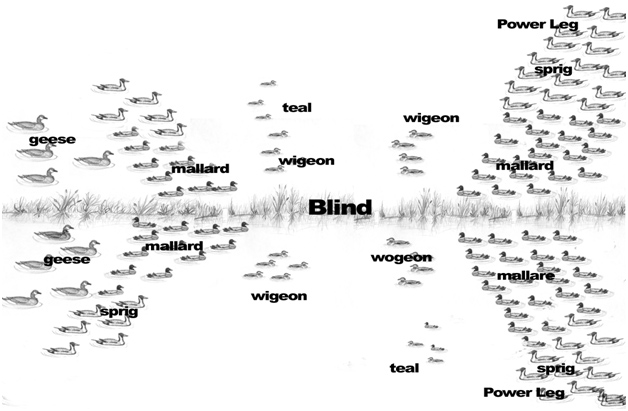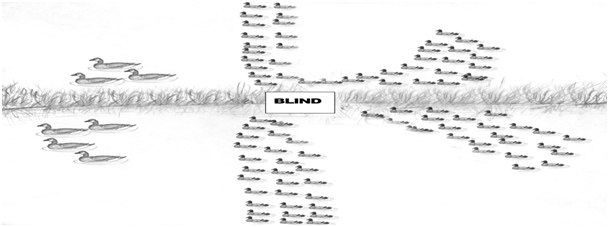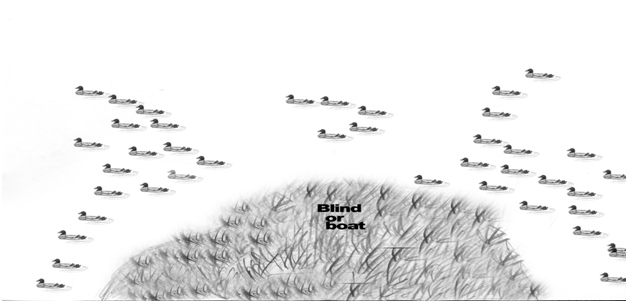
Decoy Spreads that Work
by Bill Mays
Wing and Clay Editor
DECOY’S—are probably one of the most important tools for a waterfowl hunter and, when displayed properly, can make all the difference in today’s difficult times.
One thing to keep in mind is a decoy is just an attractor and nothing more. The waterfowl hunter is using this tool to get the attention of the waterfowl and after that, the skill of calling comes into play. Size, color, numbers, and placement will make a difference between success and failure. This article will go into detail on how to enhance your decoy spreads.
Today’s waterfowl hunter has to be better than yesterday’s waterfolwer in the Sacramento Valley and many flyways throughout the country. With the duck counts down, rice enhancement, and more refuges springing up, the pressure is on.
In the years past there was always an “over flight” in the mornings, the ducks that were still in the refuge ponds and rice fields at first light. This was always the best opportunity for the waterfowl hunter to harvest quick and easy ducks. For many of the inexperience hunters this was the window of opportunity and they would harvest the majority of their limit. The ducks have become educated and can now tell time. The “over flights” are just about non-existent in many areas near a State or Federal Refuge. You can hear the bird’s picking-up and leaving for the refuge just before safe light.
Many say the ducks are becoming more and more nocturnal. If this is true than why do the ducks at Tule Lake and Lower Klamath Refuge start landing in the decoys at 1:00pm, the end of shoot time. So throw that theory out the window, let’s face it, ducks can tell time.
What this means, is today’s waterfowl hunter has to be able to call the “flight birds.”
Flight birds, are birds that are moving to and from the local refuges, private property grinds, and you must convince these ducks to land in your decoy spread. Good duck calling along with decoy spreads that are convincing are the only way to harvest these birds.
When setting a rice field decoy spread early in the season you want your X, H, or horseshoe pattern to be very wide, the wider the better. Wider, meaning 40 yards from the end of the tank with plenty of landing zones. The ducks won’t start skirting the decoy legs until later on in the season. As the season goes on and the ducks start to skirt the outside legs, take the outside legs and throw them to the inside making the opening of the decoy pattern smaller. There is a rice field illustration in this article that has proven to be very successful over my years of waterfowl hunting in the Sacramento Valley. Remember to leave runways or landing zones that lead to the tank on both sides of the blind. Rice checks that run east and west are by rule the more productive blinds, harvest more birds, and are easier to hide the hunters.

EARLY SEASON RICE HUNTING—Make it wide and look like the ducks and geese are resting, not scared and ready to bunch up and jump. Make sure you have plenty of landing zones in front of the blind on both sides of the rice check.
When you have narrowed the H-pattern later in the season and the birds is still skirting out of gun range go to a J or hook pattern. Have the leg of the J go right down the middle of the tank with the hook closest to the blind. As these ducks travel up and down the valley and successfully
skirting the legs of decoy patterns they are right in your face.

LATE SEASON RICE HUNTING—I change to a J-pattern with the leg dead center of the tank. When the ducks skirt the leg, they are right in your face.
Decoy set up for Pothole or small pond hunting is a totally different. Many times the ducks are not feeding in these areas; they are just loafing in the shade. Don’t put all the decoys in the center of the pond. Put a few of your mallard decoys in the shade around the pond. Don’t overload the pond with decoys and make sure there is plenty of room for the ducks to land. When you go shopping and there are no parking places, do you stop to shop, it’s the same concept with pothole hunting. Always try to set up with the sun to your back. Three reasons for this are, the hunter is in the shaded areas and the ducks will not pick up the blind or the hunter. The second reason is the waterfowler is not shooting into the sun and clear vision for bird identification.

REFUGE HUNTING--When hunting refuges, I like to set up on points leading into bays.
Size makes a difference in a couple of different ways. The larger the decoy in either duck or goose is always better. Hunting ducks, either on duck clubs in the rice fields, or on a State or Federal Refuge, use super magnum decoys. It’s important that the waterfowl hunter always gets that first pass when ducks are looking for a place to set down. When hunting with super magnum decoys the ducks will pick up the decoy spread faster. When hunters around you are using standard decoys and you are using super magnum decoys your harvest will increase.
Many refuge hunters will use standard or magnum decoys because they can pack more decoys into the marsh or fields. When refuge or pothole hunting with super magnum decoys, the hunter does not need as many decoys and again the ducks will pick up the spread earlier.
When a large number of decoys are needed to cover a large pond or pothole, purchase or make a decoy cart. The cart can carry waders, shotguns, blind material, tule seat, and the ducks harvested at the end of the day. Carts are very useful when hunting with a Jr. Hunter. Many times while refuge hunting, the walk can be over a mile in the dark and for junior Hunters it’s very difficult to walk that far in full hunting gear, waders, and carrying their shotgun. Remember this is supposed to be fun for Jr. Hunters, not a grueling marathon experience to difficult to achieve.
Color is as important as size in a decoy spread, the more color the better, and white is the best color attractant of all. Have more drake decoys then hen decoys in the decoy spread. I personally only use a hen “call decoy” in the front of the blind and no more than 4 hens in a pothole or refuge set up. When hunting in the rice fields with large spreads, color is still very important. Remember color is and attractant and get the first shot at the new ducks coming into a field. Painting decoys is time consuming and most people would rather be doing something else instead of painting decoys every other year, so spend the money for quality decoys. Tanglefree has a good quality decoys with a mid-range price tag that will last the hunter for years.
There are many ways to set decoys, and when the decoy spread stops working change it. Watch how the birds are finishing to the gun and make the adjustments. The goal is to get the birds within shotgun range. If the decoy spread is working don’t change it. But don’t be afraid to adjust as the season progresses, changes are usually needed late in the season. The birds tell us how they want to finish, don’t be lazy, make the adjustments, in most cases it’s only a few minutes to make the changes.
If you would like to learn more about decoy spreads, you can go to the local library for books or go to one of my professional duck hunting seminars at the International Sportsman’s Expo’s in Sacramento California on Jan.21-24, 2010.